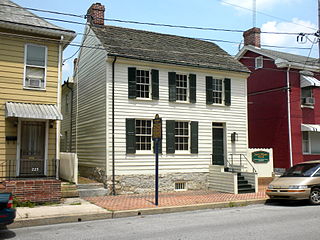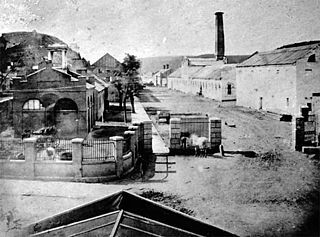 W
WBeall-Air, also known as the Colonel Lewis William Washington House, is a two-story stuccoed brick house in classical revival style near Halltown, West Virginia. It was the home of Colonel Lewis William Washington, great-great nephew of George Washington and hostage in John Brown's raid on Harpers Ferry, West Virginia.
 W
WAugust Bondi was involved in the Border War and later the American Civil War. In Kansas, he fought with abolitionist John Brown.
 W
WJohn Brown House, also known as the Ritner Boarding House, is a historic home located at Chambersburg in Franklin County, Pennsylvania. It is a two-story, three-bay wide, hewn-log building covered in clapboard. Abolitionist John Brown (1800–1859) stayed here from June until mid-October 1859, while receiving supplies and recruits for his raid on Harpers Ferry. Following the raid, four of Brown's followers returned to the house to be concealed. It is operated by the Franklin County Historical Society - Kittochtinny, as a historic house museum.
 W
WJohn Brown Tannery Site, 17620 John Brown Rd., Guys Mills, PA 16327, is a historic archaeological site located at Richmond Township, Crawford County, Pennsylvania. The tannery was built in 1825 by famed abolitionist John Brown (1800–1859), who lived on the site from 1825 to 1835. It was a major stop on the Underground Railway; Brown helped some 2,500 slaves during this period. The site includes the ruins of the tannery, a one-story, rectangular structure measuring 55 feet by 22 feet. There was a hidden room for the fugitive slaves. A fire destroyed the building in 1907. It is open to the public as the John Brown Farm, Tannery & Museum.
 W
WOwen Brown, father of abolitionist John Brown, was a wealthy cattle breeder and land speculator who operated a successful tannery in Hudson, Ohio. He was also a stout and outspoken abolitionist and civil servant. Brown was a founder of multiple institutions including the Western Reserve Anti-Slavery Society, Western Reserve College, and the Free Congressional Church. Brown gave speeches advocating the immediate abolition of slavery and facilitated the Underground Railroad.
 W
WOwen Brown, was the third son of abolitionist John Brown. Owen fought with his father in Kansas and participated in John Brown's raid on Harpers Ferry in 1859, escaping capture, and then later served as an officer in the Union Army in the American Civil War.
 W
WThe John Brown Farm State Historic Site includes the home and final resting place of abolitionist John Brown (1800-1859). It is located on John Brown Road in North Elba, near Lake Placid, New York, where John Brown moved in 1849 to lead freed slaves in farming. It was declared a National Historic Landmark in 1998. It has been managed by the state since 1896; the grounds are open to the public on a year-round basis, and tours of the house are offered in the warmer months.
 W
WJohn Brown's Fort was originally constructed in 1848 for use as a guard and fire engine house by the federal Harpers Ferry Armory in Harpers Ferry, Virginia.
 W
WThe Gibson-Todd House was the site of the hanging of John Brown, the abolitionist who led a raid on Harpers Ferry, West Virginia before the opening of the American Civil War. The property is located in Charles Town, West Virginia, and includes a large Victorian style house built in 1891.
 W
WJohn Brown is a biography written by W. E. B. Du Bois about the abolitionist John Brown. Published in 1909, it tells the story of John Brown, from his Christian rural upbringing, to his failed business ventures and finally his "blood feud" with the institution of slavery as a whole. Its moral symbolizes the significance and impact of a white abolitionist at the time, a sign of threat for white slave owners and those who believed that only blacks were behind the idea of freeing slaves.
 W
WThe John Brown Museum, also known as the John Brown Museum State Historic Site and John Brown Cabin, is located in Osawatomie, Kansas. The site is operated by the Kansas Historical Society, and includes the log cabin of Reverend Samuel Adair and his wife, Florella, who was the half-sister of the abolitionist John Brown. Brown lived in the cabin during the twenty months he spent in Kansas and conducted many of his abolitionist activities from there. The museum's displays tell the story of John Brown, the Adairs and local abolitionists, and include the original cabin, Adair family furnishings and belongings, and Civil War artifacts.
 W
WWhat his first biographer, James Redpath, called John Brown's last speech was delivered on November 2, 1859, at his sentencing, in a packed courtroom, after his conviction for murder, treason against the Commonwealth of Virginia, and inciting a slave insurrection. According to Ralph Waldo Emerson, this speech's only equal in American oratory is the Gettysburg Address.
 W
WThe Kennedy Farm is a National Historic Landmark property on Chestnut Grove Road in rural southern Washington County, Maryland. It is notable as the place where the radical abolitionist John Brown planned and began his raid on Harpers Ferry, West Virginia in 1859. Also known as John Brown Raid Headquarters and Kennedy Farmhouse, the log, stone and brick building has been restored to its appearance at the time of the raid. The farm is now owned by a preservation nonprofit.
 W
WThe Mayhew Cabin, in Nebraska City, Nebraska, is the only Underground Railroad site in Nebraska officially recognized by the National Park Service. It is included among the sites of the National Underground Railroad Network to Freedom.
 W
WThe Pottawatomie massacre occurred from May 23rd and continued until May 26th, 1856, with the killings occurring on the night of the 24th and morning of the 25th. In reaction to the sacking of Lawrence, Kansas, by pro-slavery forces on May 21, and the severe attack on May 22 on Massachusetts Senator Charles Sumner for speaking out against slavery in Kansas, John Brown and a band of abolitionist settlers—some of them members of the Pottawatomie Rifles—made a violent reply. Just north of Pottawatomie Creek, in Franklin County, Kansas, they killed five pro-slavery settlers, in front of their families. This soon became the most famous of the many violent episodes of the "Bleeding Kansas" period, during which a state-level civil war in Kansas Territory was a Tragic Prelude to the American Civil War which soon followed. "Bleeding Kansas" involved conflicts between pro- and anti-slavery settlers over whether Kansas Territory would enter the Union as a slave state or a free state.
 W
WJames Redpath was an American journalist and anti-slavery activist.
 W
WVirginia v. John Brown was a criminal trial held in Charles Town, Virginia, in October of 1859. The abolitionist John Brown was quickly prosecuted for treason against the Commonwealth of Virginia, murder, and inciting a negro insurrection, all part of his raid on the United States federal arsenal at Harpers Ferry, Virginia. He was found guilty of all charges, sentenced to death, and was executed by hanging on December 2.
 W
WHector Tyndale was a Union general during the American Civil War rising to the rank of Brevet Major General of Volunteers. He notably led brigades at the battles of Antietam and Wauhatchie. Apart from the war Tyndale was an expert in porcelain and pottery.